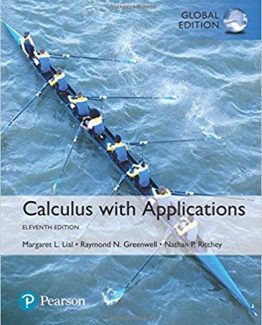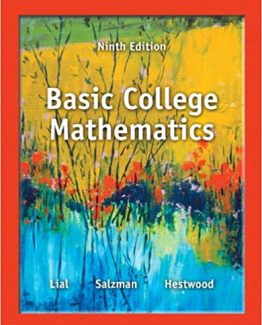Essential Mathematics for Economic Analysis 5th Edition by Knut Sydsaeter, ISBN-13: 9781292074610
[PDF eBook eTextbook]
Access code NOT included.
832 pages
Publisher: Pearson; 5 edition (July 29, 2016)
Language: English
ISBN-10: 9781292074610
ISBN-13: 978-1292074610
ESSENTIAL MATHEMATICS FOR ECONOMIC ANALYSIS
Fifth Edition
An extensive introduction to all the mathematical tools an economist needs is provided in this worldwide bestseller.
“The scope of the book is to be applauded” Dr Michael Reynolds, University of Bradford
“Excellent book on calculus with several economic applications” Mauro Bambi, University of York
New to this edition:
– The introductory chapters have been restructured to more logically fit with teaching.
– Several new exercises have been introduced, as well as fuller solutions to existing ones.
– More coverage of the history of mathematical and economic ideas has been added, as well as of the scientists who developed them.
– New example based on the 2014 UK reform of housing taxation illustrating how a discontinuous function can have significant economic consequences.
About the Author
Knut Sydsaeter was Emeritus Professor of Mathematics in the Economics Department at the University of Oslo, where he had taught mathematics for economists for over 45 years.
Peter Hammond is currently a Professor of Economics at the University of Warwick, where he moved in 2007 after becoming an Emeritus Professor at Stanford University. He has taught mathematics for economists at both universities, as well as at the Universities of Oxford and Essex.
Arne Strom is Associate Professor Emeritus at the University of Oslo and has extensive experience in teaching mathematics for economists in the Department of Economics there.
Andrés Carvajal is an Associate Professor in the Department of Economics at University of California, Davis.
Table of contents:
Sydsaeter Essential Mathematics for Economic Analysis – 5e TOC Ch01: Essentials of Logic and Set Theory1.1 Essentials of set theory1.2 Some aspects of logic1.3 Mathematical proofs1.4 Mathematical induction Ch02: Algebra2.1 The real numbers2.2 Integer powers2.3 Rules of algebra2.4 Fractions2.5 Fractional powers2.6 Inequalities2.7 Intervals and absolute values2.8 Summation2.9 Rules for sums2. 10 Newton’s binomial formula2. 11 Double sums Ch03: Solving Equations3.1 Solving equations3.2 Equations and their parameters3.3 Quadratic equations3.4 Nonlinear equations3.5 Using implication arrows3.6 Two linear equations in two unknowns Ch04: Functions of One Variable4.1 Introduction4.2 Basic definitions4.3 Graphs of functions4.4 Linear functions4.5 Linear models4.6 Quadratic functions4.7 Polynomials4.8 Power functions4.9 Exponential functions4. 10 Logarithmic functions Ch05: Properties of Functions5.1 Shifting graphs5.2 New functions from old5.3 Inverse functions5.4 Graphs of equations5.5 Distance in the plane5.6 General functions Ch06: Differentiation6.1 Slopes of curves6.2 Tangents and derivatives6.3 Increasing and decreasing functions6.4 Rates of change6.5 A dash of limits6.6 Simple rules for differentiation6.7 Sums, products and quotients6.8 The Chain Rule6.9 Higher-order derivatives6. 10 Exponential functions6. 11 Logarithmic functions Ch07: Derivatives in Use7.1 Implicit differentiation7.2 Economic examples7.3 Differentiating the inverse7.4 Linear approximations7.5 Polynomial approximations7.6 Taylor’s formula7.7 Elasticities7.8 Continuity7.9 More on limits7. 10 The intermediate value theorem and Newton’s method7. 11 Infinite sequences7. 12 L’Hopital’s Rule Ch08: Single-Variable Optimization8.1 Extreme points8.2 Simple tests for extreme points8.3 Economic examples8.4 The Extreme Value Theorem8.5 Further economic examples8.6 Local extreme points8.7 Inflection points Ch09: Integration9.1 Indefinite integrals9.2 Area and definite integrals9.3 Properties of definite integrals9.4 Economic applications9.5 Integration by parts9.6 Integration by substitution9.7 Infinite intervals of integration9.8 A glimpse at differential equations9.9 Separable and linear differential equations Ch10: Topics in Financial Mathematics10.1 Interest periods and effective rates10.2 Continuous compounding10.3 Present value10.4 Geometric series10.5 Total present value10.6 Mortgage repayments10.7 Internal rate of return10.8 A glimpse at difference equations Ch11: Functions of Many Variables11.1 Functions of two variables11.2 Partial derivatives with two variables11.3 Geometric representation11.4 Surfaces and distance11.5 Functions of more variables11.6 Partial derivatives with more variables11.7 Economic applications11.8 Partial elasticities Ch12: Tools for Comparative Statics12.1 A simple chain rule12.2 Chain rules for many variables12.3 Implicit differentiation along a level curve12.4 More general cases12.5 Elasticity of substitution12.6 Homogeneous functions of two variables12.7 Homogeneous and homothetic functions12.8 Linear approximations12.9 Differentials12. 10 Systems of equations12. 11 Differentiating systems of equations Ch13: Multivariable Optimization13.1 Two variables: necessary conditions13.2 Two variables: sufficient conditions13.3 Local extreme points13.4 Linear models with quadratic objectives13.5 The Extreme Value Theorem13.6 The general case13.7 Comparative statics and the envelope theorem Ch14: Constrained Optimization14.1 The Lagrange Multiplier Method14.2 Interpreting the Lagrange multiplier14.3 Multiple solution candidates14.4 Why the Lagrange method works14.5 Sufficient conditions14.6 Additional variables and constraints14.7 Comparative statics14.8 Nonlinear programming: a simple case14.9 Multiple inequality constraints14. 10 Nonnegativity constraints Ch15: Matrix and Vector Algebra15.1 Systems of linear equations15.2 Matrices and matrix operations15.3 Matrix multiplication15.4 Rules for matrix multiplication15.5 The transpose15.6 Gaussian elimination15.7 Vectors15.8 Geometric interpretation of vectors15.9 Lines and planes Ch16: Determinants and Inverse Matrices16.1 Determinants of order 216.2 Determinants of order 316.3 Determinants in general16.4 Basic rules for determinants16.5 Expansion by cofactors16.6 The inverse of a matrix16.7 A general formula for the inverse16.8 Cramer’s Rule16.9 The Leontief Model Ch17: Linear Programming17.1 A graphical approach17.2 Introduction to Duality Theory17.3 The Duality Theorem17.4 A general economic interpretation17.5 Complementary slackness
What makes us different?
• Instant Download
• Always Competitive Pricing
• 100% Privacy
• FREE Sample Available
• 24-7 LIVE Customer Support






Reviews
There are no reviews yet.